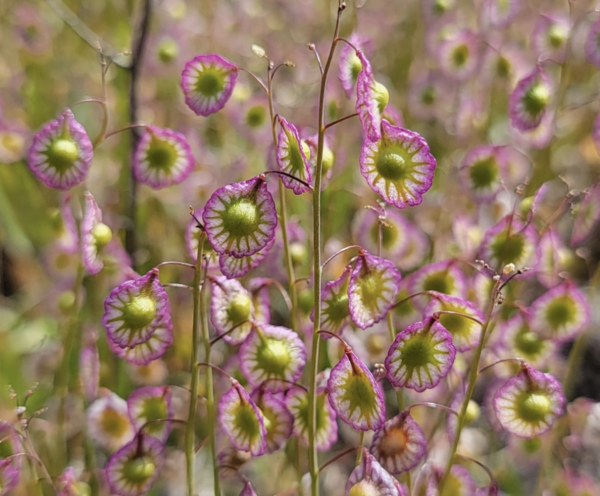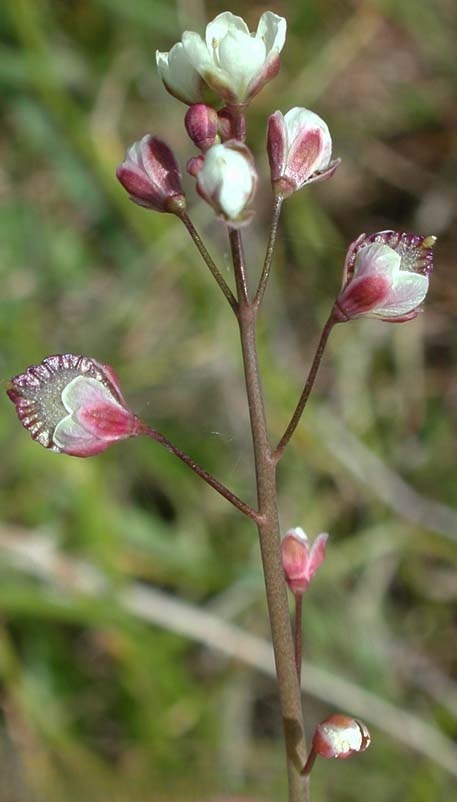Thysanocarpus radians, commonly known as ribbed fringepod or showy fringe pod, is an annual flowering plant belonging to the mustard family (Brassicaceae). Native to California and Oregon, this species is particularly notable for its distinctive seed pods that resemble a wheel with radiating spokes. Due to its delicate flowers and striking fruit, Thysanocarpus radians is appreciated both in wild habitats and as an ornamental plant.

Kingdom: Plantae
Clade: Tracheophytes
Clade: Angiosperms
Clade: Eudicots
Order: Brassicales
Family: Brassicaceae
Tribe: Thelypodieae
Genus: Thysanocarpus
Species: Thysanocarpus radians
Authority: Benth.
Thysanocarpus radians is a slender annual herbaceous plant that typically reaches a height of 50–60 cm (20–24 inches). It has an upright, thin stem that supports a delicate canopy of small leaves and flowers.
Basal leaves: Short-lived, oblong to oblanceolate, measuring 1.5–5 cm in length.
Upper leaves: Lance-shaped with auricles (small leaf-like extensions) that partially clasp the stem. The edges may be wavy or slightly lobed.
The plant produces tiny white or pale purple flowers in elongated, open racemes.
Each flower has four petals, a typical characteristic of plants in the mustard family.
The blooming period lasts from March to May.
The most striking feature of Thysanocarpus radians is its disk-shaped, flattened silique (seed pod), which dangles from a slender stalk.
The pods are 7–10 mm in diameter and feature a unique fringed, radiating pattern on their surface, resembling the spokes of a wheel.
The outer winged edge of the pod is smooth or undulating, adding to its ornamental appeal.
The seeds are single-seeded per pod, with a non-sticky outer layer when wet.

Thysanocarpus radians is native to Northern and Central California as well as parts of Oregon. It thrives in diverse habitats, including:
Moist grasslands
Open fields
Chaparral and coastal scrublands
Hillsides and disturbed areas
The species is commonly found at elevations ranging from 20 to 700 meters (65–2,300 feet).
Prefers mediterranean climates with wet winters and dry summers.
Thrives in well-drained soils, including sandy, loamy, and rocky substrates.
Requires full sun to partial shade for optimal growth.
Thysanocarpus radians is pollinated primarily by bees, butterflies, and other insects that are attracted to its small yet nectar-rich flowers.
The plant’s lightweight, fringed seed pods allow for wind-assisted seed dispersal, helping the species colonize open and disturbed areas.
The plant provides an early-season nectar source for pollinators.
Some herbivorous insects and small mammals may feed on its foliage or seeds.
Due to its delicate flowers and uniquely structured seed pods, Thysanocarpus radians is sometimes cultivated as an ornamental plant.
Often grown in wildflower gardens or native plant landscapes.
Best showcased in hanging baskets or elevated containers, where the light can highlight its translucent seed pods.
The dry seeds are edible and can be ground into flour and mixed with wheat flour for consumption. Historically, some indigenous groups may have utilized the seeds as a minor food source.
As a member of the Brassicaceae family, Thysanocarpus radians contributes to research in:
Seed dispersal mechanisms (wind-assisted distribution).
Floral evolution and pollination strategies in mustard-related plants.
Adaptations to Mediterranean ecosystems.
Best propagated through seeds, as it is an annual plant.
Sow seeds in early spring (March–April) for best results.
Soil: Prefers well-draining soil with moderate fertility.
Sunlight: Thrives in full sun, but tolerates light shade.
Watering: Requires moderate moisture, especially during germination and early growth. Avoid waterlogging.
Minimal care is needed once established.
Remove competing weeds to ensure healthy plant development.
Harvest mature seed pods if planning to reseed the area for the following year.
Urbanization and agricultural expansion have led to habitat reduction for many native wildflowers, including Thysanocarpus radians.
Non-native grasses and weeds can outcompete Thysanocarpus radians for resources, affecting its natural populations.
While Thysanocarpus radians is not currently listed as endangered, its presence in some regions may be declining due to habitat disturbances. Conservation efforts focus on preserving native grasslands and controlling invasive species.
Thysanocarpus radians is a fascinating wildflower recognized for its radiant, wheel-like seed pods and delicate blooms. As a native plant of California and Oregon, it plays an important role in local ecosystems, supporting pollinators and maintaining biodiversity. Whether admired in the wild or cultivated in a garden, this plant continues to capture the interest of botanists, gardeners, and nature enthusiasts alike.
animal tags: Brassicaceae
We created this article in conjunction with AI technology, then made sure it was fact-checked and edited by a Animals Top editor.